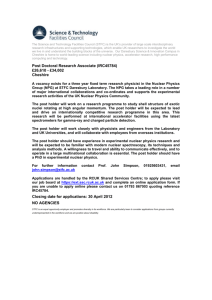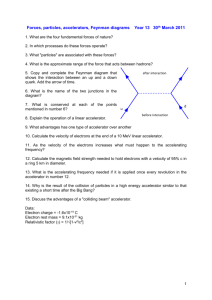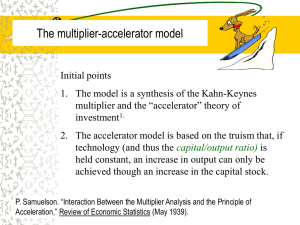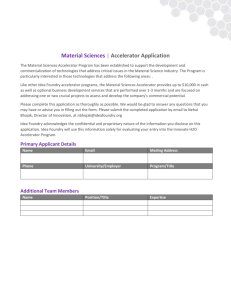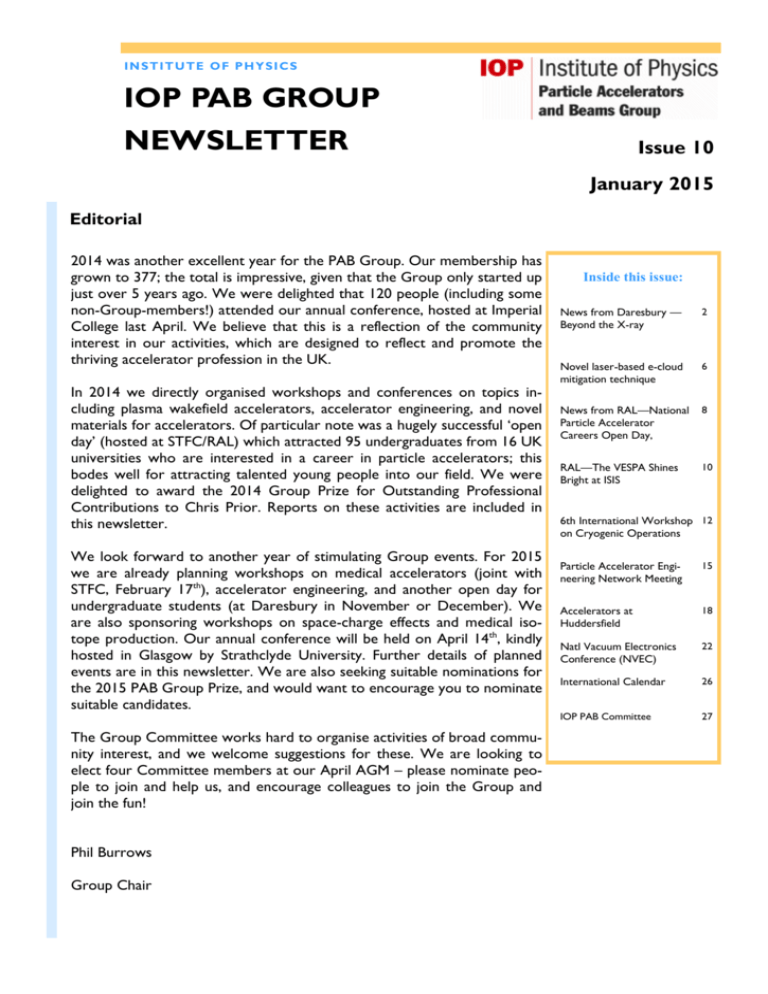
I N S T I T U T E O F P H YS I C S
IOP PAB GROUP
NEWSLETTER
Issue 10
January 2015
Editorial
2014 was another excellent year for the PAB Group. Our membership has
grown to 377; the total is impressive, given that the Group only started up
just over 5 years ago. We were delighted that 120 people (including some
non-Group-members!) attended our annual conference, hosted at Imperial
College last April. We believe that this is a reflection of the community
interest in our activities, which are designed to reflect and promote the
thriving accelerator profession in the UK.
In 2014 we directly organised workshops and conferences on topics including plasma wakefield accelerators, accelerator engineering, and novel
materials for accelerators. Of particular note was a hugely successful ‘open
day’ (hosted at STFC/RAL) which attracted 95 undergraduates from 16 UK
universities who are interested in a career in particle accelerators; this
bodes well for attracting talented young people into our field. We were
delighted to award the 2014 Group Prize for Outstanding Professional
Contributions to Chris Prior. Reports on these activities are included in
this newsletter.
We look forward to another year of stimulating Group events. For 2015
we are already planning workshops on medical accelerators (joint with
STFC, February 17th), accelerator engineering, and another open day for
undergraduate students (at Daresbury in November or December). We
are also sponsoring workshops on space-charge effects and medical isotope production. Our annual conference will be held on April 14th, kindly
hosted in Glasgow by Strathclyde University. Further details of planned
events are in this newsletter. We are also seeking suitable nominations for
the 2015 PAB Group Prize, and would want to encourage you to nominate
suitable candidates.
The Group Committee works hard to organise activities of broad community interest, and we welcome suggestions for these. We are looking to
elect four Committee members at our April AGM – please nominate people to join and help us, and encourage colleagues to join the Group and
join the fun!
Phil Burrows
Group Chair
Inside this issue:
News from Daresbury —
Beyond the X-ray
2
Novel laser-based e-cloud
mitigation technique
6
News from RAL—National
Particle Accelerator
Careers Open Day,
8
RAL—The VESPA Shines
Bright at ISIS
10
6th International Workshop 12
on Cryogenic Operations
Particle Accelerator Engineering Network Meeting
15
Accelerators at
Huddersfield
18
Natl Vacuum Electronics
Conference (NVEC)
22
International Calendar
26
IOP PAB Committee
27
Page 2
News from the Laboratories — Daresbury
Beyond the X-ray – a new frontier in structural biology
signals big gains for UK industry
2 December 2014: A UK lab has successfully taken images of the atomic structure of
materials - at a shutter speed close to one ten-thousandth of a billionth of a second.
This new imaging capability is great news for UK industry, drug discovery companies
and researchers, as it takes biological and materials research beyond the limits of what
is currently possible in the UK. It is also a step towards the ‘holy grail’ of being able to
make molecular movies.
STFC’s VELA accelerator
(Credit: STFC)
Known as ‘ultra-fast electron diffraction’ the technique is a UK first, and a remarkable
milestone for researchers at the Science and Technology Facilities Council’s (STFC)
Daresbury Laboratory in Cheshire. This makes Daresbury Laboratory one of only a
handful of sites globally that can perform ultra-fast electron diffraction, and STFC intends to ensure that UK industry and researchers can benefit from this exciting new
research tool. STFC’s newest particle accelerator, VELA (Versatile Electron Linear Accelerator), has been purpose built to assist UK industry to bridge the gap between prototypes and market ready products by making this ultrafast imaging technique available
at a fraction of the cost and physical size of facilities using other methods.
Page 3
Minister for Universities, Science and Cities Greg Clark said: "This visionary breakthrough at
Daresbury Laboratory is a further demonstration of how British expertise is pushing the boundaries of science. Not only will this development mean that the scientific community can work more
efficiently, but it could help pave the way for new treatments to use in the fight against viruses and
diseases”.
Professor Susan Smith, Head of STFC’s Daresbury Laboratory, said: “Achieving ultra-fast electron
diffraction is a major milestone for STFC. This capability can be used to develop new and better
products more cheaply, and we are really keen to work with industry and academia at this early
development stage to ensure that the potential of this technique is fully realised to the benefit of
the UK economy and society.”
Diffraction imaging itself is not new and has already led to the development of new drugs and understanding of viruses such as HIV and Foot and Mouth. However, these discoveries have relied on
high intensity X-rays that can change or destroy the tiny and fragile samples of materials that are
being studied before valuable information is gained. Ultra-fast electron diffraction imaging, which
uses very short, fast pulses of electrons, causes very little damage to these samples and can therefore take biological research beyond what is possible with X-rays on third generation light sources.
Electron diffraction from gold acquired with 1000 VELA shots in 100 seconds.
(Credit: STFC)
Page 4
This is exciting news, particularly for the drug discovery sector because it means that UK researchers will now be able to look at protein membranes in a way that they have not been able
to before. There are thousands of protein molecules within the protein membrane of one single
human cell. These proteins control the movement of substances into and out of the cell, and
send signals from the outside of the cell to the interior. These proteins are the key targets of
drugs, and over half of the drugs on the market today work by interacting with proteins in the
cell membrane. The fragility of these minute proteins limits what we can find out about them by
X-ray, but ultra-fast electron diffraction takes us beyond these limits.
VELA’s unique electron beam generates very short pulses of electrons that take images at a
shutter speed of within about one ten-thousandth of a billionth of a second, otherwise known as
100 femtoseconds. To put this into context, one femtosecond is to a second, as a second is to
approximately 31.7 million years. Development of VELA will allow even shorter shutter speeds
in future.
This ultra-fast shutter speed also puts the UK well on track to being one of the only places in
the world capable of making ‘molecular movies’ of chemical and biological processes as they
happen, meaning that VELA could be the first small-scale accelerator in the world to be able to
provide this facility, at a fraction of the cost; a goal that could be reached as soon as 2015.
STFC’s Dr Mark Surman led the experiment which achieved the ultra-fast images on samples of
platinum, aluminium and gold. Dr Surman said: “The capability that we have achieved here provides a much lower cost alternative that can be used on smaller accelerators, which might only
be a few meters in length. This is a major milestone for VELA and we are really looking forward
to taking this capability to the next level, which is to make molecular movies that can be used by
industry to develop new products.”
Dr Jonathan Underwood, of the University College London, and academic collaborator in the
development of this capability at VELA said: “This development should not be understated; with
the capability for relativistic electron diffraction at VELA coupled with the synchronised femtosecond laser systems, this instrument will have the ability to take ultra-fast snapshots during
physical and chemical change of matter at the atomic scale. This exact capability is being directly
targeted internationally by the construction of a number of large scale research facilities, but
now that this has been achieved at VELA the UK has the potential to leap-frog those international developments.”
Page 5
VELA is the result of £2.5m government investment into STFC’s Daresbury Laboratory for accelerator technology developments, as part of a series of investments across the Sci-Tech
Daresbury science and innovation campus, one of the Government’s flagship Enterprise Zones.
Contact:
Wendy Ellison
STFC Press Officer
Daresbury Laboratory
Tel: 01925 603232
Mob: 07919 548012
Calendar
Workshop on space charge
issues in charged particle
beams
Oxford, UK
23-27 Mar 2015
About VELA
The Versatile Electron Linear Accelerator (VELA) is a high performance, modular injector facility capable of delivering a highly stable, highly customisable, short pulse, high quality electron
beam to a series of test enclosures. The new facility will deliver a capability for the cutting edge
development and qualification of advanced accelerator systems, enabling industry to expedite
their technology development from prototypes to market ready products. In doing so it has the
potential to help revolutionise the use of accelerators in priority areas such as:
healthcare (imaging, radiotherapy development and sterilization)
security (cargo scanning)
energy (development of components for accelerator driven sub critical
reactors)
industrial processing (development of machines for polymer crosslinking
and rheological modification)
environment (water treatment and environmental clean-up)
and science as well as opening up further high technology commercial
markets.
VELA accelerates electrons to high energies, which can then be used to test samples of material,
produce images, or test the operation of novel accelerator components. Electron beams can
also be used to modify or improve the properties of a material by causing changes to its molecular structure.
VELA produces an electron beam of exceptionally high quality, exceeding that of any commercially available facility. This feature is aiding the development of new and compact accelerator
technologies, opening up opportunities in the UK for high-value manufacturing of commerciallyready accelerator systems.
International Particle
Accelerator Conference,
IPAC’15 (IEEE, APS)
JLab, Richmond, VA, USA
3-8 May 2015
FEL’15
Daejeon, Korea
23-28 Aug 2015
4th International Beam
Instrumentation Conference
(IBIC’15)
Melbourne, Australia
13-17 Sep. 2015
15th International
Conference on Accelerator
and Large Experimental
Physics Control Systems
(ICALEPCS 2015
Melbourne, Australia
17-23 October 2015
© Science and Technology Facilities Council (STFC)
Full details on Page 26
Page 6
Novel Low Secondary Electron Yield Engineered Surface
for Mitigation of Electron Cloud
The ASTeC Vacuum Science Group has been awarded Proof of Concept Funding (PoC) to
investigate a novel e-Cloud mitigation process. The award of £80k will support a recently
drafted patent and investigation of the potential commercialisation of this novel surface modification technique.
The ASTeC Vacuum Science Group at STFC Daresbury Laboratory, in a collaboration with the
School of Engineering at the University of Dundee (Professors Allan Gillespie and Amin Abdolvand), have recently engineered metal surfaces which have SEY < 0.8 as compared with traditional metal surfaces, which have typical SEY arond 1.9 . The technique involves rapid surface
micro- and nano-structuring in an argon and/or reactive atmosphere at room temperature using
high power nanosecond pulsed laser systems at wavelengths 1064 nm and 532 nm for processing
of aluminium, stainless steel and copper foils, respectively. The average laser energy fluence is
close to the ablation threshold of the metals. The proposed technology looks very promising for
solving the long-standing problem of electron multipacting in both the accelerator and space
communities.
The novel laser-engineered surface treatment does not introduce new material; it modifies the
microstructure of the existing surface, therefore it is expected that the impact on wall impedance and wake fields should be less than from any other e-cloud mitigation techniques. Furthermore, this technique can easily be applied to existing vacuum surfaces where the improvement
has to be done in-situ with minimum disturbance to the beam line. The treatment process is
carried out in an inert gas environment at atmospheric pressure and therefore the actual cost of
the process is considerably lower than other existing mitigation processes. The surface is highly
reproducible and offers a very stable surface chemistry which can be influenced during the process. The surface is robust and is immune to any surface delamination, which can be a detrimental problem for thin film coatings. The treated surface remains the same material, therefore
it is unlikely to cause a serious effect on the surface impedance - and this has recently been verified.
Page 7
Early stage results for SEY of Cu as a function of incident electron energy for as-received and
conditioned samples: Cu – untreated surface, Black Cu – treated surface.
© 2015 Science and Technology Facilities Council - All Rights Reserved.
US Patent Granted to ASTeC for Innovative Magnet Design
ASTeC have been granted a US Patent for a permanent magnet-based variable strength multipole magnet (patent number 8,829,462) which has been developed for the CLIC Linear Collider
project at CERN. ASTeC has already built two prototypes which have been successfully tested
both at Daresbury and at CERN. The team are now developing new ideas for permanent magnet dipoles with variable field strength, again funded by the CLIC project.
High Strength Quadrupole
Credit: STFC)
Low Strength Quadrupole
(Credit: STFC)
Page 8
News from the Laboratories — RAL
National Particle Accelerator Careers Open Day, RAL, Nov. 2014
On the 26th of November 2014, the Rutherford Appleton Laboratory hosted the National
Particle Accelerator Careers Open Day, sponsored by the Institute of Physics, the Science and
Technology Facilities Council (STFC), the John Adams Institute for Accelerator Science (JAI) and
the Cockcroft Institute of Accelerator Science and Technology (CI). The day was organised to
show university undergraduates what a rich variety of post-graduate careers and training options
are available in the world of particle accelerators. Building on the success of last year’s event at
Daresbury Laboratory, the event attract a total of 95 students from 16 universities from as far
afield as Edinburgh, Sheffield, Cardiff and Brighton, with particularly strong attendance from
Portsmouth and Birmingham. Spreading the word to universities not usually associated with
accelerators is a key PR and recruitment goal for the accelerator community, so getting a good
mix on the day was excellent. Also well received was the strong attendance of female students at
30% of the total.
Starting with a networking session over a buffet lunch, the day moved on to a series of talks.
STFC CEO John Womersley welcomed the group and described the valuable work that STFC
undertakes for UK science. Phil Burrows from the JAI performed admirably, listing in just 15
minutes the mind-boggling array of possible paths students could take, emphasising the
importance of collaborations between the three main sectors of academia, national laboratories
and industry. Suzie Sheehy from STFC’s Accelerator Science and Technology Centre (ASTeC)
described the exciting opportunities afforded by PhD studies of accelerators. Hayley Smith from
ISIS gave a very interesting account of operating the ISIS synchrotron as part of the STFC
graduate scheme. Finally Per Bergfjord and Stephen Towe from Elekta discussed the fast-paced
life of a commercial medical accelerator company manufacturing two linacs every day.
Page 9
After the talks were two further activities. The group had the opportunity to discuss career
options in person with 15 exhibitors from national labs, universities and industry; the exhibition
was a lively event with hands-on activities, demonstrations, video displays and even lollipops
given away by the Culham Centre for Fusion Energy (CCFE)! Next, the group enjoyed tours of
the many accelerator facilities on site at the Rutherford Appleton Laboratory, including the ISIS
and Diamond synchrotrons, the Front End Test Stand (FETS) and the Muon Ionisation Cooling
Experiment (MICE). The students found it exciting to see real working equipment, particularly
appreciating seeing inside the ISIS synchrotron during a rare shutdown period.
Overall, the Careers Open Day was a great success and very smoothly kept to time. Feedback
was excellent, with both the students and exhibitors appreciating the chance to network and find
out more about the many career opportunities available in the accelerator sector.
scott.lawrie@stfc.ac.uk
sara.fletcher@stfc.ac.uk
Page 10
The VESPA Shines Bright at ISIS
The Vessel for Extraction and Source Plasma Analyses (VESPA) is a new ion source test area now
operating at ISIS. It will be used to demonstrate the production of negative hydrogen (H –) ions in
a much more efficient manner than is currently done on the operational machine. H – ion beams
are notoriously difficult to produce in both large quantities and in a consistent manner needed
for an operational facility. A group of ten ion sources are in rotation at ISIS, each routinely producing 50 mA of pulsed beam current for about a month before needing to be replaced. To do
this requires three 19” racks worth of equipment – much of which is operating near its maximum
rating – and a lot of experience. The VESPA aims to remove some pieces of kit that are no longer strictly necessary, and to run those that remain in a much calmer regime. These changes
should bring greater operational reliability to the ion source section, thus enhancing the overall
up-time of ISIS.
The key to achieving these goals is to understand fully the fine details of the plasma from
which H– ions are extracted. The plasma is only the size of a fingertip, so is far too small for conventional diagnostics to probe. Instead, the VESPA uses a high resolution optical monochromator
to study the beautiful pink light emission from the plasma. This gives vital information about the
processes happening inside the ion source and helps refine plasma and beam simulations.
Another aspect which will be studied is the extracted beam itself. On ISIS, the first beam measurement device is positioned after a small magnet which is believed to collimate the beam heavily.
In fact, it has been proposed that up to 100 mA of beam is extracted from the plasma but is subsequently lost on its way through the magnet, leaving only 50 mA to be measured downstream.
The VESPA has the magnet removed and for the first time the full extracted beam has indeed
been recorded to be over 100 mA – a great result! Once this beam has been fully characterised,
new focusing optics will be installed which will prepare the beam for loss-less injection into the
ISIS Radio Frequency Quadrupole (RFQ).
Page 11
As well as these main spectroscopy and beam measurements, many other experiments will be
performed on the VESPA; including a compact electrostatic chopper, a larger plasma chamber
and a caesium detector. The VESPA is fully compatible with the ISIS mechanical fixtures, and
therefore if all measurements go as planned, the hope is to install a higher power, more efficient,
more reliable VESPA ion source on ISIS in the next long shut-down, currently scheduled for
2018.
scott.lawrie@stfc.ac.uk
ISIS
Notice is hereby given that the
Annual General Meeting of the Particle Accelerators and Beams Group will be held
at 12:30 on 14th April 2015 at John Anderson Building, University of Strathclyde,
Glasgow.
AGENDA
1) Apologies for absence
2) Minutes of previous AGM
3) Chair’s report
4) Treasurer’s report
5) Honorary Secretary’s report
6) Election of committee/group officers
7) Any other business (please notify the Honorary Secretary in advance)
The group is always looking for enthusiastic members to join the group committee. The committee normally meets about 5 times a year. Its work includes organising topical workshops in
the field of particle accelerators and beams, producing a group newsletter, awarding prizes for
distinguished achievement in the field and providing expert advice on consultations.
Nomination for committee members/group officers are invited and should be made to the honorary secretary, Peter Williams (peter.williams@stfc.ac.uk ) before 1st April. An election will be
held to fill the following vacancies:
Honorary Secretary
Ordinary Member x 4
If you cannot attend the AGM but have any issues you would like to be raised at the meeting,
please contact the honorary secretary.
No fee is charged to attend the Annual General Meeting.
Peter Williams
Hon. Secretary IOP PAB Group
Page 12
6th International Workshop on Cryogenic Operations
From discovering Higgs Bosons at the LHC or providing ultralow temperature environment for
the experiments with ISIS neutrons, one of the key technologies that must be employed reliably
is CRYOGENICS. A major fraction of the construction and operational budget, particularly for
the large scientific experiments is allocated to Cryogenics. Several new large projects like XFEL
in Germany, ESS in Sweden, ITER in France, LCLS-II in the US and also the mid-range test
facilities like ALICE at Daresbury Laboratory, all of which employ Superconducting technology
(SRF cavities and magnets) rely heavily on the reliable operations of the cryogenic systems.
Considering the size and complexity of Cryogenics technology such a goal can only be achieved
through worldwide co-operation.
Recognising such a need a workshop series called ‘Cryo-Ops’ was introduced in 2004 at J-Lab in
the US to provide a forum for engineers, technicians and operators responsible for Cryogenic
operations to share their knowledge and experiences and also to discuss future challenges.
Held every alternate year Cryo-Ops has now become a successful series and STFC Daresbury
Laboratory was honoured to host Cryo-Ops 2014, the 6th International Workshop on
Cryogenic Operations. More than 100 delegates from Scientific Laboratories and Industries
from 14 countries participated at the event organised by ASTeC at the Cockcroft Institute from
November 10-12, 2014. A variety of issues ranging from maintenance, reliability and economics
to safety and staff training including some of the future challenges were discussed. It was also for
the first time the cryogenics community form RAL, DLS and DL came together at DL and
identified a range of areas for collaborations in the field.
Page 13
Professor Susan Smith addressing the delegates at the Liverpool Football Club
While addressing the delegates at the banquet organised to celebrate the 10th anniversary of the
Cryo-Ops series at the Liverpool Football Club Susan Smith, the head of Daresbury
Laboratory and Director of ASTeC, stressed the importance of team work and coordination for
successful delivery and execution of scientific projects. Earlier Dana Arenius (from J-Lab), the
inaugural chair of the Cryo-Ops series was honoured to cut the 10th anniversary cake at the
welcome reception hosted by Peter Ratoff, Director of the Cockcroft Institute.
Dana Arenius, the inaugural Chair of the Cryo-Ops workshop series cutting the 10th
Anniversary cake at the Welcome reception hosted by Professor Peter Ratoff, Director of the
Cockcroft Institute
Page 14
The participants also took an opportunity to visit various cryogenics related projects at the lab.
To conclude the workshop after three days of serious technical discussions the delegates
visited Lewis Carroll Centre, the beautiful church that celebrates Daresbury’s famous villager,
the creator ofAlice in Wonderland an 1865 novel written by Charles Lutwidge Dogson under
the pseudonym ‘Lewis Carroll’.
Rachael Buckley explaining the cryogenics system for ALICE, during the site tours
The concluding sessions at the Lewis Carroll Centre
Page 15
Accelerator Engineering Network
The first meeting of the Accelerator Engineering Network was held at the IMechE headquarters
in London in October. The network, run in partnership with the IoP PAB group, IET and IMechE,
was set up to provide a networking forum specifically for engineers and technicians working on
accelerators.
The delegates attending the accelerator engineering network meeting
Over 100 engineers from industry, national labs and universities heard interesting talks from a
wide range of speakers:
Per Bergfjord from Elekta the oncology company gave a very interesting talk about how they
manufacture more than one linac every day for cancer treatment. Amos Dexter from Lancaster
University gave a very informative talk about phase synchronisation systems for RF. Jim Kay, head
of engineering at Diamond light source described the extreme engineering challenges that had to
be overcome to achieve very brilliant beams in the electron storage ring. Neil Bliss, Group
Leader at the Engineering and Technology Centre Daresbury Laboratory, talked about how they
have been contracted to use their engineering expertise to deliver key technologies for the ELINP project in Romania. Stephen Jago, Accelerator Design Engineering Group Leader at ISIS
described how to make radiation hard concrete magnets. Tom Jones from the Engineering and
Technology Centre Daresbury showed some wonderfully detailed multiphysics simulations of RF
Structures.
After a very fruitful networking lunch the talks continued with Mark Iskander from e2v giving a
very educational talk about modulators for magnetrons. Imran Tahir from Rapiscan the scanning
company gave a talk about applications of commercial linacs including an amazing system that can
scan an entire train travelling at 60 mph. Yifeng Yang from Southampton University gave a very
interesting and informative talk about how to get high current feeds from room temperature to
cryogenic superconducting magnet windings.
Page 16
The highlight of the day was Frédérick Bordry, CERN’s Director for Accelerators and
Technology. An engineer himself, Frédérick gave a fascinating talk about the vast scale and scope
of the engineering required to build the most amazing machine on earth: The LHC.
The keynote speaker: CERN’s Director for Accelerators and Technology Frédérick Bordry.
At the end of the day there was an open discussion about the future of the Accelerator
Engineering Network. There was general agreement that we should hold another event in 2015.
Dr Amos Dexter delivering his presentation
Page 17
The IET Communities Development Manager Fiona Dew (left) presents a certificate and
£100 Amazon voucher to Emmy Sharples (right) the winner of the IET Young Engineer
poster prize.
Emmy Sharples from Lancaster University won the Young Engineer poster prize for her work on
metamaterial loaded accelerator components. Dan Faircloth, the network chairman said, “It was
a very close competition between excellent candidates, the future of accelerator engineering in
the UK looks very bright.”
The next accelerator engineering network meeting will be held in the autumn. If you have any
ideas or suggestions for future events or would like to get involved with the network please
contact the organising committee on the emails below.
All the talks are available online within the meeting agenda at:
https://eventbooking.stfc.ac.uk/news-events/particle-accelerator-engineering-network-219
dan.faircloth@stfc.ac.uk
graeme.burt@cockcroft.ac.uk
Page 18
Accelerators at Huddersfield
The International Institute for Accelerator Applications (IIAA) at Huddersfield has expanded
rapidly since its inception nearly four years ago. Huddersfield has, up till now, been known as a
typical Yorkshire industrial town with a fine musical and choral tradition, though it is also
responsible for Rugby League and the Luddite riots. So we have a strong historical background
to draw on.
The university's strategy was to boost its research standing by targeted investment in key areas
that were going to blossom in future. It identified accelerators as just such an area ¨C a choice
with which all readers of this newsletter would hopefully agree heartily. We did not set out to
compete with other groups ¨C particularly our university and ASTeC neighbours in the North
West ¨C but to complement them. Yes, I know the term 'complementary' is grossly over-used,
but we have genuinely focussed on applications, rather than principles, and on proton machines
rather than electron light-sources, as others are fully engaged there. There is so much to be
done in the accelerator field, and still not enough people to do it; plenty of scope for increasing
the size of the cake so that everyone gets a bigger slice.
The staff grew slowly but steadily: Bob Cywinski was joined by Rob
Edgecock, then Roger Barlow, Jaap van den Berg, Sue Kilcoyne and
Becky Seviour. The student population exploded: from one PhD
student at the start to 16 PhD and 4 MSc students today. (We
have a unique taught MSc programme.) Our first accelerator PhD
thesis is now on the library shelf (see left, with its author): on its
lonesome for now, but hopefully to be joined by others very soon.
Many of the students spend some time away from the university, at
labs like PSI, CERN, and CNAO.
A major feature at Huddersfield is MEIS. (Medium Energy Ion
Scattering ¨C not to be confused with any similar sounding
accelerator project!) This is a 200 keV proton (or light ion)
source, with a sophisticated target and DAQ system that
detects the energies and angles of recoil ions. This joint
distribution opens up possibilities to study the intimate details
of the first few layers of the target structure, which is really
useful for catalysis, corrosion, silicon chip manufacturers, and
other surface science applications. The apparatus used to be
at Daresbury (much of the kit goes all the way back to the old
NSF injector), and when STFC decided they couldn't continue
with it, they kindly let us give it a new home.
Page 19
The whole apparatus - it fills two rooms - came
down the M62 and over the Pennines in
innumerable orange crates. It has taken two
years of dedicated effort to reassemble it and
recommission it, but this has finally been
completed and we feel confident enough to
have organised our an official opening on March
3rd this year. (All welcome ¨C see the web for
details.) As well as its use for research and for
commercial applications, which we are now
starting to generate, it's good for us as a
university accelerator group to have a real even if small - accelerator in our own labs.
For large accelerators one has to look further afield, and we have
several joint projects with CERN: on LHC collimation (together with
Manchester and RHUL), on the MEDICIS project for medical isotope
production at Isolde, and on the proposed BioLEIR/MedPhys beamline.
We are also working with the accelerator design team in Lund on
several aspects of the European Spallation Source, on which work has
already started. (The picture shows Bob Cywinski together with former
ESS director Colin Carlisle at the foundation ceremony.) First beam is
scheduled for 2019 ¨C that's going to take a lot of hard work by a lot of
accelerator scientists and engineers, giving real opportunities for
collaborators to contribute.
We have developed a particular strength in target simulations.
We've done a lot of studies of the ISIS target, and the Front End
Test Stand at RAL. We use Geant4, Fluka, MCNPX and other
programs to model the effects of beams on targets. Sometimes this
is to study shielding requirements. Sometimes it is to optimise the
design to increase the production rate of the desired neutrons or
muons. Sometimes it is to look at the production of particular
useful isotopes, perhaps for medical imaging, perhaps for other,
more out-of-the-way uses,like the production of 8Li as a neutrino
source for the proposed DAEdALUS/ISODAR experiment.
This interest in targetry - and in FFAGs, another of our areas of research - has led to a strong
involvement in accelerator driven reactors and thorium as a nuclear fuel which is safer and
cleaner than uranium/plutonium. Huddersfield is the UK centre for ADSR and thorium nuclear
studies. The topic arouses a lot of interest and we give lots of talks, get called by the media, and
address meetings at party conferences and in the Houses of Parliament
We also work on RF properties, particularly the use of
metamaterials. At RF wavelengths these can be constructed
macroscopically to have the desired permittivity and
permissivity properties ¨C which can be highly non-classical ¨C
giving rise to some very interesting and potentially useful
effects. Together with photonic crystals with explicitly
constructed band gaps, these open up new possibilities for
accelerating structures.
Page 20
As an Institute for accelerator applications we also
work on the use of, in particular, muons and neutrons,
as are produced at ISIS and PSI. One recent study was
an analysis of medieval cannon balls: these large round
black balls turn out to contain iron inside ¨C usually a
rough cube, as shown on the left: a neutron image for
which the outer lead layer is almost transparent.
Nobody really seems to understand why: was there
some military advantage in having a lighter centre? Or
was it just cheaper? No instruction manuals seem to
have survived from the 15th century to explain the
manufacture.
Proton therapy is another area very important for us. We
work with the Cancer Centre at Clatterbridge, and also the
centres at Pavia in Italy and Nice in France, and look forward
to the opening of the NHS centres in Manchester and UCL.
Like many others, we have argued the case for proton therapy
in the UK, we are delighted that this is now actually going to
happen, and we look forward to contributing to the work in
the coming months and years.
We've come an astoundingly long way in 4 years. While there are still some people who claim
never to have heard of Huddersfield, despite our 'University of the year' award, there are not
many left. We've done some amazing things already, and we're only just getting started.
Roger Barlow
Director of the Huddersfield IIAA
Workshop on Accelerators for Medicine
On Tuesday February 17th 2015, STFC will be hosting a joint Workshop in conjunction with
the IOP Particle Accelerators and Beams Group, on accelerators for medicine. The workshop
will provide a high level overview of the work being carried out, the key players in the area and
highlight any other relevant activities and events that are scheduled to take place. The workshop
will be held at the Franklin Theatre at the Institute of Physics in London.
The event will include talks from both UK and international speakers. Five UK accelerator experts will to talk about their work in this area and the international experts will provide perspectives from overseas. These talks will help to stimulate a discussion on how the UK can
develop its strategy and optimise its impact in the context of the global programme in this area.
The aim of the workshop will be to gather the views of the community and a discussion will be
held to talk about the relevant areas in which the STFC can play a leading role.
The event will run from 10.00 until 17.00.
You can register for this event at http://www.stfc.ac.uk/ASBworkshop
Page 21
2014 PAB Group Prize for
Outstanding Professional Contributions
Chris receives his prize from Phil Burrows, PAB Group Chair
At the AGM last March, we were delighted to award the 2014 Group Prize for Outstanding
Professional Contributions to Christopher Prior, Leader of the Intense Beams
Group at ASTeC.
The citation reads:
To Christopher Prior for his seminal contributions to the mathematical
modelling of intense particle beams — in particular for his development of
novel simulation methods and codes; for his generation of innovative
accelerator concepts; for his educational and intellectual leadership; and
for his many related contributions to the success of state-of-the-art
accelerator facilities in the UK and around the world.
The PAB Group is seeking suitable nominations for the 2015 PAB Group Prize, and would want
to encourage you to nominate suitable candidates.
Further information can be found at:
http://www.iop.org/activity/groups/subject/pab/prize/page_56571.html
Page 22
National Vacuum Electronics Conference (NVEC)
National Vacuum Electronics Conference
(Credit: DL Media Services)
This year’s National Vacuum Electronics Conference (NVEC) took place on the 5 th June 2014 at
Daresbury Laboratory (STFC) in the Cockcroft Institute. The aim of the conference is to focus
on early career researchers and staff members (PhD student / PDRA level) and it provides an
excellent opportunity for researchers and engineers from both academia and industry to present
and discuss on-going developments and advances in Vacuum Electronics, RF Science and
Engineering research.
The opening plenary talk was on ‘Commissioning of the Mice RF System’, given by Andrew Moss
of ASTeC, and was followed by eleven further talks during the day, covering a wide range of
topics from vacuum tube design (klystrons and gyratrons), equivalent circuit models for cavity
tuning, metamaterial research, Terahertz radiation, to gun and cavity design. These were
provided by students from University of Huddersfield, Lancaster, London and Strathclyde and
generated lively discussion. In addition CST provided a talk during the lunch break on the latest
upgrades to Microwave Studio.
Next year’s NVEC is to be hosted at University of Strathclyde.
Alan Wheelhouse, Daresbury
Page 23
Novel Magnetic Sensors and Their Applications
STFC Knowledge Exchange Workshop
Rutherford Appleton Laboratory, STFC Harwell Oxford, Didcot OX11 0QX
Date: 12th March 2015
The STFC Innovations Club is hosting an event on Novel magnetic sensors and their
applications. The workshop will address the following type of sensors and their applications:
• Quantum Well Hall Effect (QWHE) sensors
• Portable SQUID magnetometers
• Fluxgate magnetometers
• Characterisation tools for functional magnetic materials
The sensors based on advanced Quantum Well Hall Effect (QWHE) display
unprecedented sensitivity and dynamic range ( > 180dB) allowing magnetic fields
down to 1nT to be measured in an active volume of less than 0.001 mm3.
• These sensors support 2D planar and conformal array geometries on rigid and flexible
substrates which opens possibilities not possible with induction techniques.
• There also have advantages in integrated circuits, mass production, repeatability, low power
consumption, ease of use and lower costs.
A SQUID (superconducting quantum interference device) is a very sensitive
magnetometer used to measure extremely subtle magnetic fields, based on superconducting
loops containing Josephson junctions. SQUIDs are sensitive enough to measure fields as low as 5
aT (5×10-18 T) and reach a noise level of ~fTHz-1/2.
Applications of magnetic sensors
• High-accuracy magnetometry, long-range position sensing, angular position sensing, current
sensing, magnetic scanning of documents
• Non Destructive Testing (NDT), monitoring asset integrity, use of radiation hard camera for
nuclear industry
• Magnetic near-field communications and sensing, the markets span oil & gas, defence and niche
custom applications with products in low data-rate underwater communications, data logging,
sensing and induction power transfer
• Extremely low magnetic fields detection (e.g. detection of underground water level and its
salinity).
For more information contact: Dr Vlad Skarda, STFC (vlad.skarda@stfc.ac.uk)
To register go to: Novel Magnetic Sensors and Their Applications
Page 24
Accelerators: Powering Cutting Edge Research l
by Charlotte Houghton (STFC)
left: inside cover. 3D model of Diamond Light Source. Image credit: Diamond Light Source
right: Accelerators brochure front cover. Image credit: STFC
A brand new brochure (Sep 2014) will help accelerator scientists explain the benefits of their work to the general public. By using real-life examples and scenarios
everybody can relate to, Accelerators: Powering Cutting Edge Research explores
the many areas in which accelerator science has made a positive impact on modern
life.
The brochure has been produced by STFC, the Cockcroft Institute and the Institute of Physics. It
has been commissioned to raise public awareness of the benefits of particle accelerators in research, through case studies that answer questions such as:
How can we meet our energy needs without adding to greenhouse gas emissions?
How will border protection agencies, and the technology they use, continually evolve to face
the ever growing threat of terrorist attacks?
How can we find new ways of preserving our cultural heritage?
Featuring particle accelerators from around the world, the brochure highlights how accelerators influence our everyday lives by covering topics such as:
Energy- solar cells, keeping the lights on at power stations and turning carbon monoxide
into fuel.
Radiotherapy- treating cancer patients, improving diagnosis and radiotherapy efficiency, and
developing new cancer treatments.
Medicine- treating HIV, detecting Parkinson’s disease and dealing with diabetes.
The environment- storing hydrogen, studying clouds and decontaminating Fukushima.
Industry- fuelling the economy, making life sweeter and making aircraft safer.
Security- detecting terrorist threats, solving mysterious deaths and fighting counterfeiters.
Page 25
PAB GROUP & UK EVENTS
Workshop on Accelerators for Medicine — STFC in conjunction with IoP PAB Group
IoP, London, Franklin Theatre
17th February 2015,
AGM of the PAB Group
John Anderson Building, University of Strathclyde, Glasgow
14th April 2015
Useful Links
http://www.scitech.ac.uk/
http://www.cockcroft.ac.uk/
http://www.adams-institute.ac.uk/
www.diamond.ac.uk
http://www.desy.de/index_eng.html
http://www.linearcollider.org/newsline/
Page 26
INTERNATIONAL CALENDAR
CLIC Workshop 2015
CERN
26- 30 Jan 2015
http://indico.cern.ch/event/336335/timetable/#20150126.detailed
EuCard2/Xbeams workshop devoted to space charge issues in charged particle beams
Oxford, UK , 23-27 Mar 2015
http://www.cockcroft.ac.uk/events/SpaceCharge15
International Particle Accelerator Conference, IPAC’15 (IEEE, APS)
Jefferson Lab, Richmond, VA, USA, 3-8 May 2015
https://www.jlab.org/conferences/ipac2015/
Free Electron Laser Conference, FEL’15
Daejeon, Korea, 23-28 Aug 2015
13th International Conference on Heavy Ion Accelerator Technology (HIAT 2015)
Yokohama, Japan, 7-11 Sep 2015
www.nishina.riken.jp/hiat2015
4th International Beam Instrumentation Conference (IBIC’15)
Melbourne, Australia 13-17 Sep. 2015
15th International Conference on Accelerator and Large Experimental Physics Control Systems
(ICALEPCS 2015
Melbourne, Austyralia
17-23 October 2015
http://www.icalepcs2015.org/
Upcoming schools
Joint Universities Accelerator School (JUAS)
Archamps, Haute Savoie, France
12-20 March 2015
Page 27
The Institute of Physics
The Institute of Physics
76 Portland Place
Phone: 020 7470 4800
Fax: 020 7470 4848
London
W1B 1NT,
UK
IoP Particle Accelerators and Beams Group
IoP PAB Committee
Chair: Prof. Phil Burrows (Oxford)
Secretary: Dr. Peter Williams (Daresbury)
Treasurer: Dr. Brian McNeil (Strathclyde)
Prof. Allan Gillespie (Dundee); Newsletter
Dr. Hywel Owen (Manchester); Web Manager
Dr. John Thomason (RAL)
Prof. Mike Poole (Daresbury)
Prof. Susan Smith (Daresbury)
Mr. Aled Jones (AWE)
Dr. Riccardo Bartolini (Diamond Light Source & JAI)
Dr. Adina Toader (Manchester)
Dr. Jonathan Smith (Tech-X UK): Industrial representative
James Henderson (Strathclyde); co-opted student
Deadline for submissions to the
next newsletter is
29 May 2015
Disclaimer:
This newsletter is also available on the web and in larger print sizes
The contents of this newsletter do not necessarily represent the views or policies of the Institute of Physics, except
where explicitly stated.



